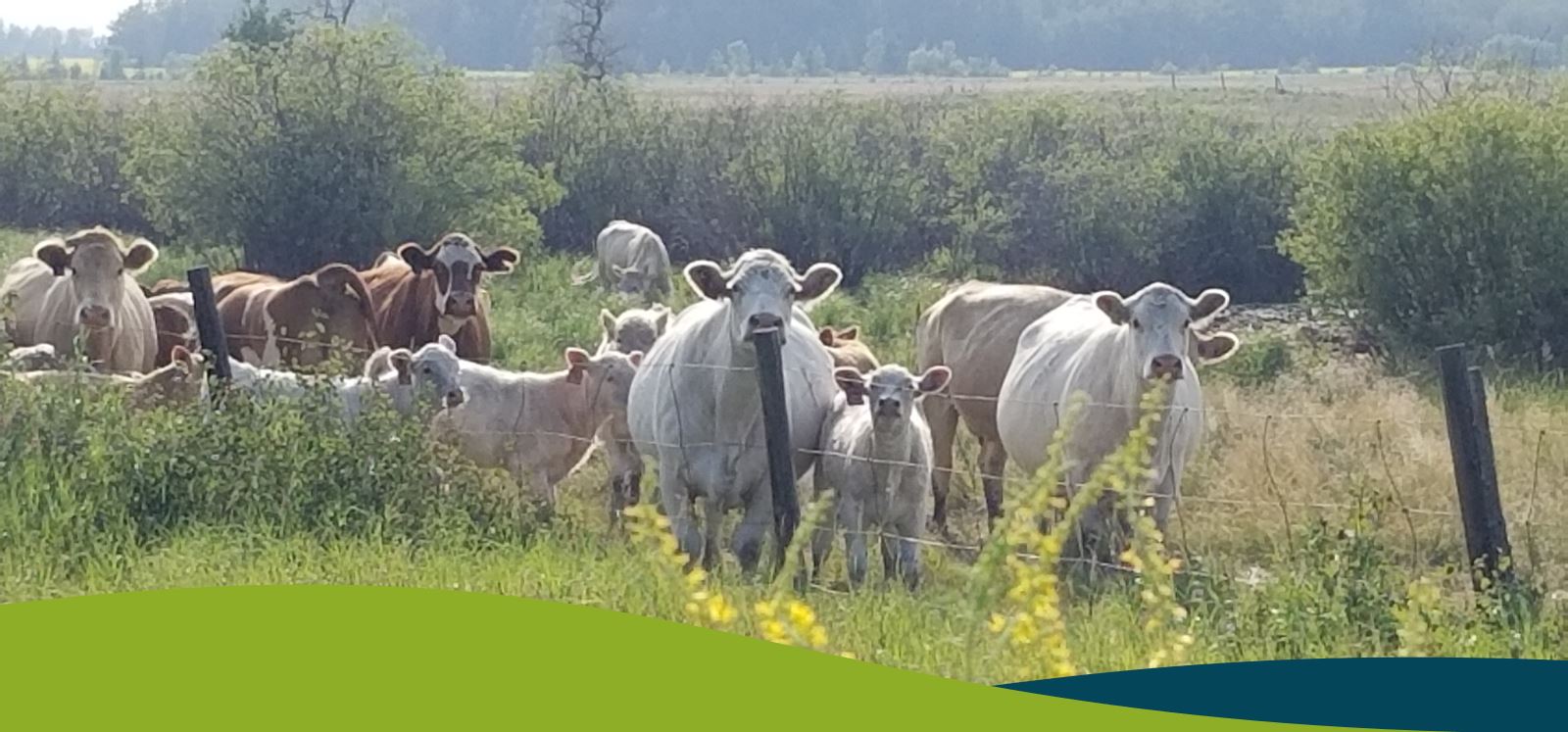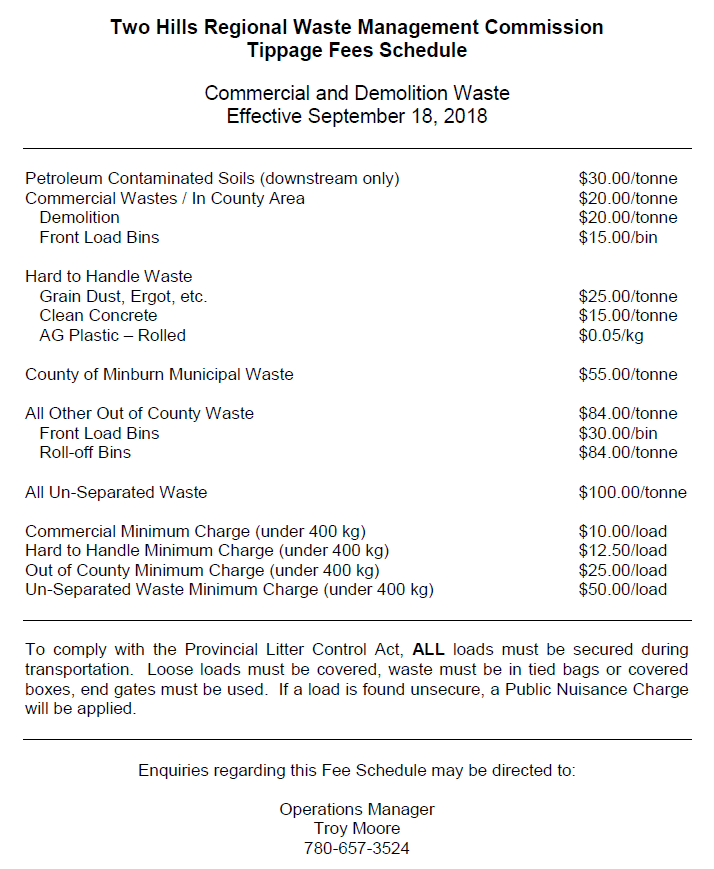Landfill
Two Hills Regional Waste Management Commission
About the Landfill
The County of Two Hills Regional Landfill Authority was formed in 1989 to operate the new sanitary landfill site. This Authority included the County of Two Hills, Village of Willingdon, Village of Myrnam, Village of Derwent and the Town of Two Hills. The new site, along with five transfer sites, were developed with the help of Alberta Environment in the form of a capital grant program that funded 100 percent of the cost. The Regional Landfill site was selected in part because of compatibility of ground water analysis (over 100 wells were drilled to extract this information) and being centrally located to provide services to the entire County of Two Hills. A site plan was created to ensure proper operations at the Regional Landfill as well as the five transfer sites. All sites were designed to accept municipal waste and recyclables. A scale house with shop area was built at the Regional Landfill site; a new 50 tonne scale and 953C track loader were also supplied with the grant.
In the late 1990s, the County of Two Hills Regional Landfill Authority moved towards a Service Commission and in the year 2000, the Two Hills Regional Waste Management Commission was formed (AR 49/2000). Instead of being a department of the County of Two Hills, the Commission would operate independently. However to keep costs from rising to fund new administrative staff, the County of Two Hills staff play a vital role in assisting the Commission with its work.
In 2006 the Commission purchased a side-load waste truck to provide the whole County of Two Hills with services that would benefit both rural and urban areas with waste pickup.
In April 2013 the Commission started a 10 year contract with the County of Minburn to provide waste pickup for the County of Minburn along with the Village of Innisfree, Village of Minburn and Town of Mannville.
As of March 2015, the Commission has completed 9 cells that contain approximately 81,000 tonnes of municipal waste. The Commission has recycled approximately 900 tonnes of tires since 2000, 3750 tonnes of metal since 1990, 72 tonnes of e-waste since 2006 and 15 tonnes of batteries since 2000.
Two Hills Regional Waste Management Commission
Tips to Help
- Weather can affect the conditions at the disposal site.
- Expect to encounter muddy conditions when it has rained.
- Expect drifts at sites if it has snowed within the last two days.
- Loads that have been separated before hand will speed up the disposal at the sites.
- Burn barrels can stay hot up to 3 weeks. Caution must be used when disposing of ash.
- Waste oil may be taken to the Regional Landfill.
- Burn pits are for clean wood only. No rail ties, treated lumber, wood with plastic attached or shingles. No plastic material allowed.
- Tire spots are for tires only. No rubber products allowed.
To comply with the Provincial Litter Control Act, ALL loads must be secured during transportation. Loose loads must be covered, waste must be in tied bags or covered boxes, end gates must be used. If a load is found unsecure, a Public Nuisance Charge will be applied.
Please help to keep our facilities and roadways to the disposal facilities clean.
Two Hills Regional Waste Management Commission
Transfer Sites - Regulations and Guidelines
Waste
- Non-hazardous household waste
- Plastic
- Cardboard
- Food scraps
- Paper
- Garbage bags
- Clothes
- Tile
- Drywall
- Mattresses
- Couches
- Rubber mats
- Wood material
- Burn pit for all clean wood
Recyclables
- Recycling of metal, tires, electronics, empty oil containers, oil filters and pesticide jugs
- Collection of household hazardous chemical containers (Myrnam and Willingdon Transfer Sites only)
- Collection of paint cans (Derwent, Hairy Hill, Myrnam and Willingdon Transfer Sites only)
Prohibitive Wastes
- Large dead animals (larger than a dog)
- Full automobiles, large machinery
- Liquid waste (sewage effluent)
- Hazardous industrial waste
- Biological and pathological waste
- Radioactive waste
- Oil, hydraulic fluid
- Oilfield waste
- Dry rubble (concrete, rocks, shingles, soil)
- Loads that will not fit in waste containers
Procedures
- All loads brought to the Transfer Site must be tarped or secured to prevent waste from falling onto roadways
- Waste emptied into waste containers at the Transfer Site should be in bags or contained to prevent waste blowing around the site
- Follow Site Supervisor instructions for proper conduct at the site and placement of waste
- No scavenging of material from household waste
- Scavenging of recyclables allowed under Site Supervisor discretion
- Burn barrels must be cold
- Smoking near flammable material is prohibited
To comply with the Provincial Litter Control Act, ALL loads must be secured during transportation. Loose loads must be covered, waste must be in tied bags or covered boxes, end gates must be used. If a load is found unsecure, a Public Nuisance Charge will be applied.
Please help to keep our facilities and roadways to the disposal facilities clean.
Two Hills Regional Waste Management Commission
Regional Landfill - Regulations and Guidelines
Waste
- Non-hazardous household waste
- Plastic
- Cardboard
- Food scraps
- Paper
- Garbage bags
- Clothes
- Tile
- Drywall
- Mattresses
- Couches
- Rubber mats
- Concrete
- Shingles
- Wood material
- Burn pit for all clean wood
Recyclables
- Recycling of waste oil, empty oil containers, oil filters
- Recycling of metal, tires, electronics, batteries and pesticide jugs
- Recycling of clean concrete (no metal)
- Recycling of agricultural plastic (rolled and less than 5% contamination)
- Collection of household hazardous chemical containers and paint cans
Prohibitive Wastes
- Large dead animals (larger than a dog)
- Full automobiles, large machinery
- Liquid waste (sewage effluent)
- Hazardous industrial waste
- Biological and pathological waste
- Radioactive waste
- Oilfield waste
- Soil that is deemed hazardous
- Loads that will not fit in waste containers
Procedures
- All loads brought to the Regional Landfill must be tarped or secured to prevent waste from falling onto roadways
- Follow Site Supervisor instructions for proper conduct at the site and placement of waste
- No scavenging of material from household waste
- Scavenging of recyclables allowed under Site Supervisor discretion
- Burn barrels must be cold
- Smoking near flammable material is prohibited
To comply with the Provincial Litter Control Act, ALL loads must be secured during transportation. Loose loads must be covered, waste must be in tied bags or covered boxes, end gates must be used. If a load is found unsecure, a Public Nuisance Charge will be applied.
Please help to keep our facilities and roadways to the disposal facilities clean.


